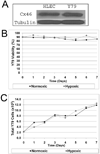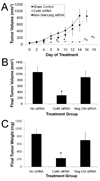Treatment with connexin 46 siRNA suppresses the growth of human Y79 retinoblastoma cell xenografts in vivo
- PMID: 21320488
- PMCID: PMC3060947
- DOI: 10.1016/j.exer.2011.02.003
Treatment with connexin 46 siRNA suppresses the growth of human Y79 retinoblastoma cell xenografts in vivo
Abstract
Tumors with a hypoxic component, including human Y79 retinoblastoma cells, express a specific gap junction protein, Connexin 46 (Cx46), which is usually only found in naturally hypoxic tissues such as the differentiated lens. The aim of this study was to investigate if Cx46 downregulation would suppress Y79 tumor formation in vivo. Five-week old nude mice were subcutaneously implanted with human Y79 retinoblastoma cells and treated with intratumor siRNA injections of 30 μg Cx46 siRNA (n = 6), 30 μg non-silencing siRNA (n = 6), or no siRNA treatment (n = 6) every 2 days for a maximum of 10 treatments. Tumor volume (TV) was calculated from the recorded caliper measurements of length and width. Excised tumors were measured and weighed. Western blot analyses were performed to evaluate Cx46 and Cx43 expression in tumors which received Cx46 siRNA, non-silencing siRNA, or no siRNA treatment. Tumor histopathology was used to assess tumor features. Cx46 siRNA treated Y79 tumors had a reduced TV (287 mm(3) ± 77 mm(3)) when compared to the tumors of mice receiving the negative control siRNA (894 mm(3) ± 218 mm(3); P ≤ 0.03) or no siRNA (1068 mm(3) ± 192 mm(3); P ≤ 0.002). A 6-fold knockdown of Cx46 and a 3-fold rise in Cx43 protein expression was observed from western blots of tumors treated with Cx46 siRNA compared to mice treated with non-silencing siRNA. Knockdown of Cx46 with siRNA had an antitumor effect on human Y79 retinoblastoma tumors in the nude mouse model. The results suggest that anti-Cx46 therapy may be a potential target in the future treatment of retinoblastoma.
Copyright © 2011 Elsevier Ltd. All rights reserved.
Figures








Similar articles
-
A novel role of gap junction connexin46 protein to protect breast tumors from hypoxia.Int J Cancer. 2010 Aug 15;127(4):839-48. doi: 10.1002/ijc.25107. Int J Cancer. 2010. PMID: 20013805 Free PMC article.
-
Dysregulation of miR-204-3p Driven by the Viability and Motility of Retinoblastoma via Wnt/β-catenin Pathway In Vitro and In Vivo.Pathol Oncol Res. 2020 Jul;26(3):1549-1558. doi: 10.1007/s12253-019-00722-0. Epub 2019 Sep 3. Pathol Oncol Res. 2020. PMID: 31482398
-
Pioglitazone inhibits growth of human retinoblastoma cells via regulation of NF-κB inflammation signals.J Recept Signal Transduct Res. 2017 Feb;37(1):94-99. doi: 10.3109/10799893.2016.1171341. Epub 2016 May 1. J Recept Signal Transduct Res. 2017. PMID: 27133446
-
VEGF-targeted RNA interference suppresses angiogenesis and tumor growth of retinoblastoma.Ophthalmic Res. 2007;39(2):108-15. doi: 10.1159/000099247. Epub 2007 Feb 2. Ophthalmic Res. 2007. PMID: 17284938
-
Targeted pharmacologic inhibition of S-phase kinase-associated protein 2 (SKP2) mediated cell cycle regulation in lung and other RB-Related cancers: A brief review of current status and future prospects.Adv Biol Regul. 2023 May;88:100964. doi: 10.1016/j.jbior.2023.100964. Epub 2023 Mar 14. Adv Biol Regul. 2023. PMID: 37004354 Review.
Cited by
-
Complementary expression and phosphorylation of Cx46 and Cx50 during development and following gene deletion in mouse and in normal and orchitic mink testes.Am J Physiol Regul Integr Comp Physiol. 2015 Aug 1;309(3):R255-76. doi: 10.1152/ajpregu.00152.2015. Epub 2015 May 27. Am J Physiol Regul Integr Comp Physiol. 2015. PMID: 26017495 Free PMC article.
-
Investigation of the reciprocal relationship between the expression of two gap junction connexin proteins, connexin46 and connexin43.J Biol Chem. 2011 Jul 8;286(27):24519-33. doi: 10.1074/jbc.M110.217208. Epub 2011 May 23. J Biol Chem. 2011. PMID: 21606502 Free PMC article.
-
Molecular deregulation induced by silencing of the high mobility group protein A2 gene in retinoblastoma cells.Mol Vis. 2012;18:2420-37. Epub 2012 Oct 3. Mol Vis. 2012. PMID: 23077401 Free PMC article.
-
The role of Connexin 46 promoter in lens and other hypoxic tissues.Commun Integr Biol. 2012 Mar 1;5(2):114-7. doi: 10.4161/cib.18715. Commun Integr Biol. 2012. PMID: 22808311 Free PMC article.
-
Carbon monoxide (CO) is a novel inhibitor of connexin hemichannels.J Biol Chem. 2014 Dec 26;289(52):36150-7. doi: 10.1074/jbc.M114.602243. Epub 2014 Nov 10. J Biol Chem. 2014. PMID: 25384983 Free PMC article.
References
-
- Abramson DH, Beaverson KL, Chang ST, Dunkel IJ, McCormick B. Outcome following initial external beam radiotherapy in patients with Reese-Ellsworth group Vb retinoblastoma. Arch Ophthalmol. 2004;122:1316–1323. - PubMed
-
- Antoneli CB, Ribeiro KC, Steinhorst F, Novaes PE, Chojniak MM, Malogolowkin M. Treatment of retinoblastoma patients with chemoreduction plus local therapy: experience of the AC Camargo Hospital, Brazil. J. Pediatr. Hematol. Oncol. 2006;28:342–345. - PubMed
-
- Behike MA. Chemical modification of siRNAs for in vivo use. Oligonucleotides. 2008;18:305–319. - PubMed
Publication types
MeSH terms
Substances
Grants and funding
LinkOut - more resources
Full Text Sources
Miscellaneous

